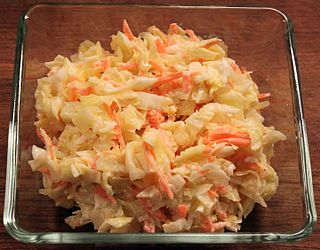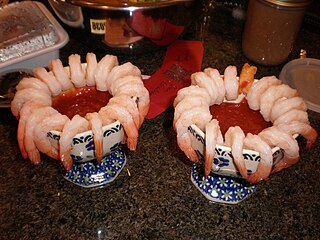
Trifle is a layered dessert of English origin. The usual ingredients are a thin layer of sponge fingers or sponge cake soaked in sherry or another fortified wine, a fruit element, custard and whipped cream layered in that order in a glass dish. The contents of a trifle are highly variable and many varieties exist, some forgoing fruit entirely and instead using other ingredients, such as chocolate, coffee or vanilla. The fruit and sponge layers may be suspended in fruit-flavoured jelly, and these ingredients are usually arranged to produce three or four layers. The assembled dessert can be topped with whipped cream or, more traditionally, syllabub.

English cuisine encompasses the cooking styles, traditions and recipes associated with England. It has distinctive attributes of its own, but is also very similar to wider British cuisine, partly historically and partly due to the import of ingredients and ideas from the Americas, China, and India during the time of the British Empire and as a result of post-war immigration.

Belgian cuisine is widely varied among regions, while also reflecting the cuisines of neighbouring France, Germany and the Netherlands. It is sometimes said that Belgian food is served in the quantity of German cuisine but with the quality of French food. Outside the country, Belgium is best known for its chocolate, waffles, fries and beer.
Dione Lucas was an English chef, and the first female graduate of Le Cordon Bleu. Her father was the architect, jeweller and designer Henry Wilson, and her sister was the violinist Orrea Pernel (1906–1993). She married another architect, Colin Lucas (1906–1984).

Coleslaw, also known as cole slaw, or simply as slaw, is a side dish consisting primarily of finely shredded raw cabbage with a salad dressing or condiment, commonly either vinaigrette or mayonnaise. This dish originated in the Netherlands in the 18th century. Coleslaw prepared with vinaigrette may benefit from the long lifespan granted by pickling.

A schnitzel is a thin slice of meat. The meat is usually thinned by pounding with a meat tenderizer. Most commonly, the meat is breaded before frying. Breaded schnitzel is popular in many countries and is made using veal, pork, chicken, mutton, beef, or turkey. Schnitzel originates in Austria as wiener schnitzel and is very similar to dishes such as escalope in France and Spain, panado in Portugal, tonkatsu in Japan, cotoletta in Italy, kotlet schabowy in Poland, řízek in Czech Republic, milanesa in Latin America, chuleta valluna in Colombia, chicken chop in Malaysia, and chicken-fried steak and pork tenderloin of the United States.

Deviled eggs, also known as stuffed eggs, Russian eggs, curried eggs or dressed eggs, are hard-boiled eggs that have been peeled, cut in half, and filled with the yolk, mixed with other ingredients such as mayonnaise and mustard. They are generally served cold as a side dish, appetizer or a main course during gatherings or parties. The dish's origin can be seen in recipes for boiled, seasoned eggs as far back as ancient Rome, where they were traditionally served as a first course. The dish is popular in Europe, North America and Australia.

Constance Spry was a British educator, florist and author in the mid-20th century.

Cocktail sauce, also known as seafood sauce, is one of several types of cold or room temperature sauces often served as part of a dish referred to as a seafood cocktail or as a condiment with other seafoods. The sauce, and the dish for which it is named, are often credited to British celebrity chef Fanny Cradock, but seafood cocktails predate her 1967 recipe by some years.

Gratin dauphinois is a French gratin of sliced raw potatoes baked in cream, from the Dauphiné region in south-eastern France. There are many variants of the name of the dish, including pommes de terre dauphinoise, potatoes à la dauphinoise and gratin de pommes à la dauphinoise. It is distinguished from ordinary gratin potatoes by the use of raw rather than boiled potatoes. It is a quite different dish from pommes dauphine.

Afghan cuisine is influenced to a certain extent by Persian, Central Asian and Indian cuisines due to Afghanistan's close proximity and cultural ties. The cuisine is halal and mainly based on mutton, beef, poultry and fish with rice and Afghan bread. Accompanying these are common vegetables and dairy products, such as milk, yogurt, and whey, and fresh and dried fruits such as apples, apricots, grapes, bananas, oranges, plums, pomegranates, sweet melons, and raisins. The diet of most Afghans revolves around rice-based dishes, while various forms of naan are consumed with most meals. Tea is generally consumed daily in large quantities, and is a major part of hospitality. The culinary specialties reflect the nation's ethnic and geographic diversity. The national dish of Afghanistan is Kabuli palaw, a rice dish cooked with raisins, carrots, nuts, and lamb or beef.
Jubilee chicken can refer to one of several chicken dishes created to celebrate the jubilees of different British monarchs.

A cordon bleu or schnitzel cordon bleu is a dish of meat wrapped around cheese, then breaded and pan-fried or deep-fried.
Rosemary Ethel Hume was an English cook and writer. She taught at Le Cordon Bleu cookery school in London, and co-devised coronation chicken in 1953.

The Platinum Pudding is a British pudding consisting of a lemon and amaretti trifle. It was created by Jemma Melvin in 2022 for a competition celebrating the Platinum Jubilee of Queen Elizabeth II.













